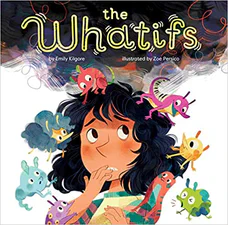The Whatifs

Recommended Age Range: Kindergarten through 3rd grade.
Publisher's Summary:
Cora is constantly worrying about everything. Because of this, the Whatifs love her. They sneak up to her and give her all kinds of doubts: big or small, silly or frightening, likely or impossible. As she prepares for an upcoming piano recital, the Whatifs cling on tighter and drag her down, making her anxious about messing up during the concert. Will she be able to change her worry-filled thoughts into hopeful ones?

Dr. Annie's Takeaways
Recommended for: Kids who are inclined to think that worst possible scenarios will happen may benefit from this book’s messages that our Whatifs (in this book, pictured as cute flying monsters) can be both “grim” (e.g., “What if my dog runs away) and hopeful (e.g., “What if there’s chocolate cake after our recital”), and that more hopeful Whatifs help us to feel better and often come true. The main character Cora is anxious about a piano recital; this book could also be great to read with children who get particularly anxious about performances.
Would a child like it? It’s fairly child-friendly. The Whatifs are cute, and it could inspire a fun craft project of drawing a bunch of Whatifs–both “grim” and hopeful and talking about which ones are most likely to come true.
Evidence-Based Practices:
Cognitive Restructuring
Tone: Encouraging
Story Quality: The description of Cora’s “Whatifs” is great–they’re little bug-monsters that flit about whispering worries to her no matter where she goes. Kids with worries will relate to this description. The turning point of the story happens when a peer of Cora’s introduces her to the idea that Whatifs can be hopeful, too (e.g., “What if I play better than ever”), which helps Cora to imagine positive outcomes instead of negative ones. The transition is really fast, even for a picture book, which makes it a little inauthentic-seeming.
Illustrations: Richly-colored, emotionally evocative watercolor illustrations with a bit of darkness. The Whatifs are cute, colorful little flying monsters.
Representation: Cora is a girl with light skin and dark brown or black hair. Her friend Stella has a similar complexion and hair color. The other children pictured in the book (basketball teammates, piano students) are White, Brown, and Black.
Psychological Practices: This book teaches a cognitive restructuring
strategy of thinking about possible positive outcomes in addition to possible negative ones. Kids with a lot of worries usually think of the possible negatives, and with practice can start to consider that good outcomes might also occur. Cora is particularly nervous about an upcoming piano recital and has a lot of worries about it not going well (e.g., “What if my fingers shake?”; What if I make a mistake?”). This aspect of the book makes it applicable to children with performance anxiety. With the help of her friend, she is able to consider that the concert might go well and that there might be chocolate cake after. When she does make a mistake, she’s able to use her new “what if” strategy to think, “What if I CAN do this.”
Concerns: For some kids with a lot of worries, the strategy of replacing negative “what ifs” with positive ones can feel invalidating. I would introduce this book as a way of discussing the idea that we don’t know what the outcome of anything will be, and if we assume that it will always be bad, we’re missing out on the fact that it might be good some of the time. This strategy would prevent this book from turning into the message that children should just look on the bright side or always think positive, which is not helpful to a child with a lot of worries, or to anyone, really.
